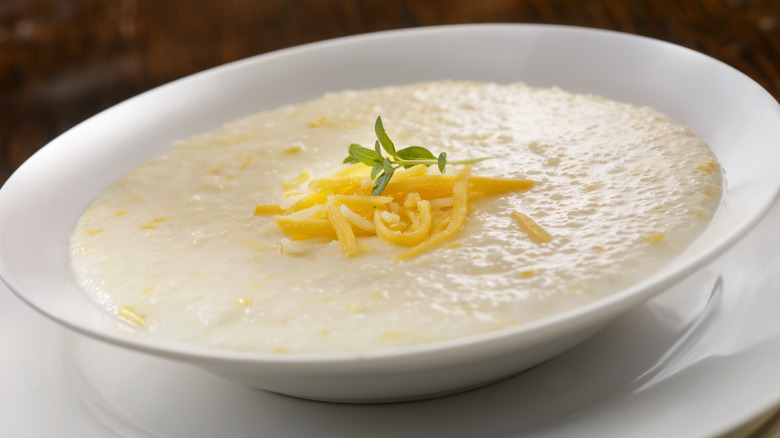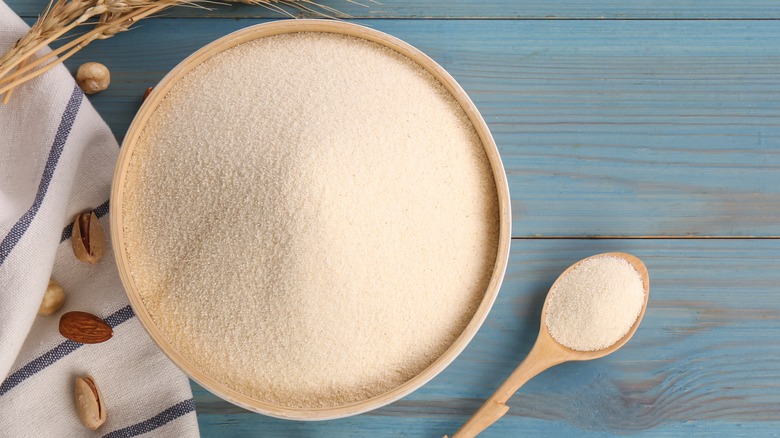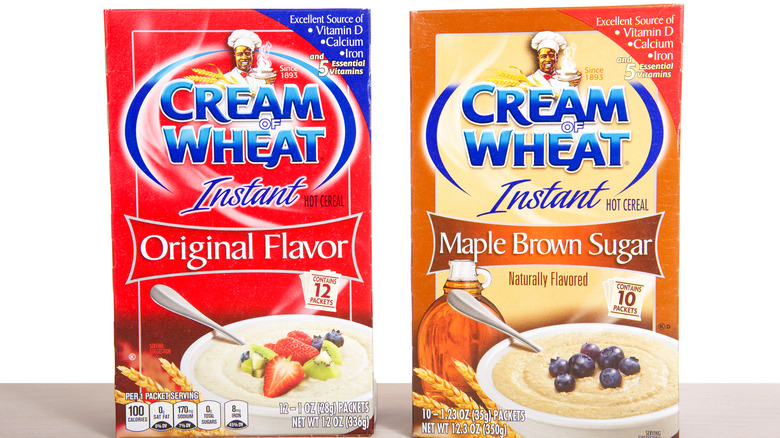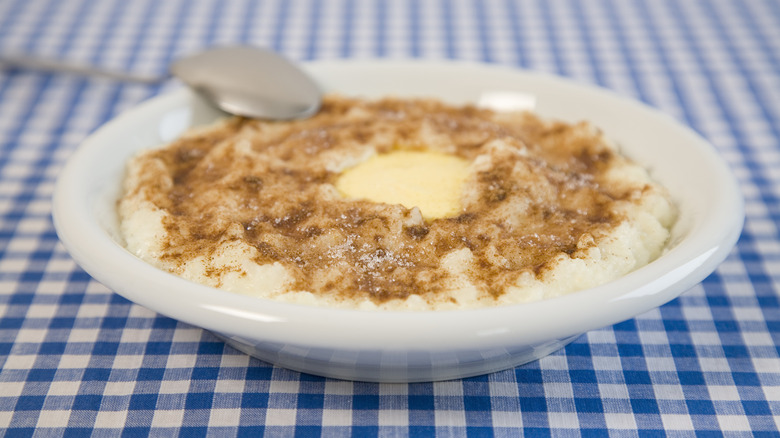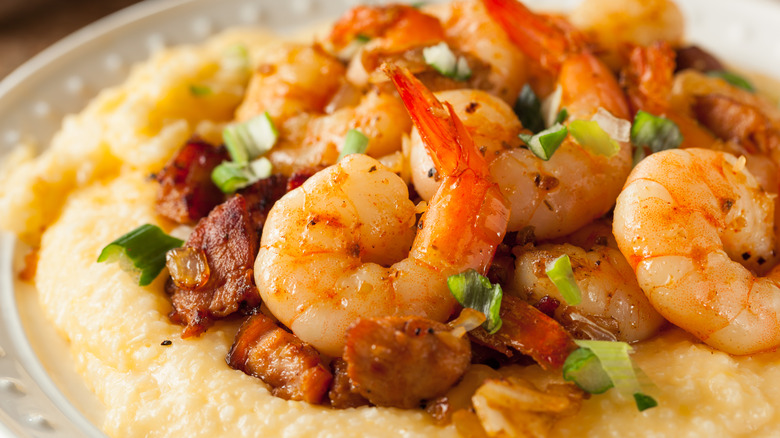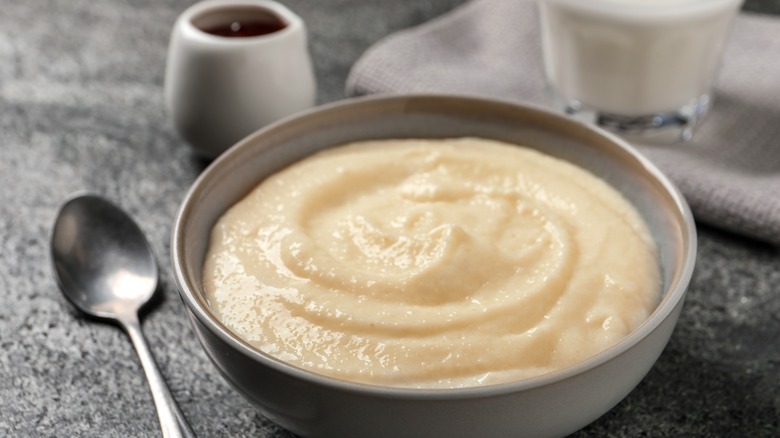What's The Difference Between Grits And Cream Of Wheat?
If one were to take a look at a bowl of grits and then a bowl of Cream of Wheat, they might be tempted to say that the two are the same (or at least very similar) things. And in a way, they are: Both are a type of porridge, which is a hot, creamy dish created by boiling grains to make them soft enough to eat. This is pretty much where their similarities end, however.
Grits, as anyone from the American South can tell you, are a savory dish made from corn. Cream of Wheat, as anyone who can read the name could probably guess, is a sweet dish made from wheat. This gives them two very different tastes as well as two very different textures. They are served differently as well, and they can be eaten at different times of day. While no one would blame you for mixing them up at first glance, this Southern girl would be remiss if she didn't teach you how to differentiate one from the other.
What are grits?
Grits are a comfort food consumed mostly in the South. In fact, they are such an integral part of Southern culture that Georgia made grits the state's official prepared food in 2002.
But what, exactly, are grits? That's simple: Grits are a creamy dish made from ground dent corn, which is a softer type of maize. This delicacy was invented in the 1600s by the Muskogee tribes of Native Americans, who lived in what is now Alabama, Florida, Georgia, and Tennessee. It was passed on to colonists via trading, as a more processed version of dent corn called hominy was often used as currency at the time.
Since then, not much has changed in terms of the making and cooking of grits. Raw corn is ground into a coarse, gritty powder and boiled in salted water to make a thick, still gritty, porridge. This porridge can be eaten for breakfast, as a side dish, or even a full lunch or dinner. While grits are most comparable to Italian polenta, another dish made from ground corn, polenta is made from a harder type of corn and has a more "al dente" texture and a brighter yellow color.
What is Cream of Wheat?
While the term "grits" is the name of a food, "Cream of Wheat" is actually the name of a brand and product. Like grits, Cream of Wheat is an American style of porridge, served as a hot breakfast cereal similar to oatmeal. But unlike grits and oatmeal, Cream of Wheat is made from ground wheat. Specifically, it is made from what is called the "middlings" of wheat, which is the part that is not used to make flour.
Cream of Wheat was created by the Diamond Milling Company in Grand Forks, North Dakota, in 1893. It was a time of economic depression, and the company was looking for a way to make ends meet as flour demand was diminishing. Things were at a standstill until Diamond's chief miller, Tom Amidon, came up with the idea of selling a type of porridge made from the wheat middlings, which his wife often cooked for them for breakfast.
Amidon and his team shipped some of this porridge mix — which they christened "Cream of Wheat" — to the company's owners with a new shipment of flour. In return, they received a telegram that read: "Forget the flour. Send us a car of Cream of Wheat" (via the Lancaster New Era). The rest is history.
Grits come in four main varieties
While people typically just use the word "grits," there are actually four different types of this ground corn concoction. The first is stone-ground grits, which are made from whole, dry corn kernels. These kernels are coarsely ground up between two stones and represent what was most likely the original form of grits. These take around an hour or more to cook, as they start off in a harder form.
Hominy, on the other hand, is often sold pre-cooked in cans, which only takes a few minutes to heat up on the stove. It can also be found in a dry and coarse form, which can require several hours of simmering time. The difference between hominy grits and stone-ground grits is that hominy is composed of kernels of corn that have been soaked in lye or lime to weaken and remove the outer shells, leaving just the interior part, a process known as nixtamalization.
Next up are quick grits, which are ground into a finer powder than the above-mentioned types of grits, and thusly require just five minutes of boiling on the stove. A subset of this type, known as "regular grits," is a bit coarser and takes 10 minutes to cook.
Last but not least, we have instant grits, which have already been cooked and dehydrated, so all you have to do is add boiling water and you've got a meal. These aren't quite as tasty as the other varieties, but they are definitely much quicker to prepare.
Cream of Wheat has a wide range of products
Cream of Wheat originally just came in one flavor, but the brand has been regularly adding more ingredients and faster cooking options over the course of its more than 100-year history. Unlike grits, which, without additions, essentially come in the one flavor (boiled corn), Cream of Wheat has tons of one-purchase choices, such as Cocoa Nut, Bananas & Cream, Maple Brown Sugar, Cinna-Apple Walnut, Mixed Berry, and Whole Grain. The brand also still offers several iterations of the original flavor as well, to which you can add your own mix-ins like brown sugar, fruit, nuts, or chocolate chips.
If you check out the company's website, you can find Cream of Wheat with cooking times that range from two and a half minutes to "instant," something that is harder to find with grits. Cream of Wheat also offers small, convenient "To-Go Cups" and a variety of vitamin-enriched products.
Grits are a savory dish
One of the main differences between grits and Cream of Wheat is their taste. While both are prepared by boiling ground grain in hot water, they are nonetheless made of two completely different grains.
Since grits are made from corn, they have a distinctively light, "corny" taste that serves as their signature. In fact, one of the best ways to describe them is that they taste like cornbread, if that cornbread had been melted down to a not-quite-liquid form. Aside from the saltiness they get from the water they are cooked in, their flavor is very neutral, which is why you rarely see anyone eating their grits as-is. The grits need help from butter or other ingredients in order to be tasty.
Cream of Wheat, on the other hand, is more like your classic hot breakfast cereal. This porridge, too, has a neutral, admittedly bland, flavor on its own, which is why it is usually served with (and sometimes cooked in) milk and topped with sweet additions like sugar or maple syrup.
Cream of Wheat is (obviously) creamier
Perhaps the biggest thing that sets grits and Cream of Wheat apart is their texture. While both are fairly mushy and wet, Cream of Wheat, as its name implies, is the creamier of the two. It's still a bit grainy, but the pieces of wheat inside are very small and not really big enough to chew, although it's also not perfectly smooth. The mixture is thick and warm, and many people find it comforting to eat.
Grits, as their name also implies, are usually grittier than Cream of Wheat. The pieces of corn inside are more coarsely ground, so they're not as smooth as Cream of Wheat. That being said, there are some who prefer their grits on the runnier side and others who prefer them a bit drier. Either way, the mouthfeel of both grits and Cream of Wheat is something of an acquired preference, which is why both dishes have as many detractors as they do fans.
Cream of Wheat has far more calcium
We know that grits and Cream of Wheat are two completely different things, but how do they stack up nutritionally? Let's take a look at them in their base, bland form with no additives and see how they compare.
When it comes to protein, grits are the winner here, with 4.4 grams of protein per cup, as compared to Cream of Wheat's 2.84 grams per cup. Cream of Wheat, however, has less total fat, with just 0.41 grams per cup as opposed to 1.18 grams for grits. Grits have more carbs, with 38 grams per cup versus Cream of Wheat's 20.68 grams, and Cream of Wheat has only 0.06 grams of total sugars. Grits have 0.308 grams.
Both contain vitamins and minerals like folate and folic acid, magnesium, and similar amounts of phosphorus, but if you're looking to increase your calcium intake, you'll want to go with Cream of Wheat, as it contains 86.48 milligrams of calcium per cup (and that's when cooked in just water). A cup of grits, meanwhile, only contains 2.57 milligrams of calcium.
Grits are good any time of day
Grits are a savory dish that can be eaten for practically any meal. For breakfast, they can be eaten simply with butter or cheese, or you can go all out and prepare them with sausage and gravy for a big, down-home, country-style way to start the day.
For lunch and dinner, you have even more options. Shrimp and grits are so popular that Georgia's Jekyll Island dedicates a festival to them each year, but there are also fish and grits, Parmesan grits, ham and grits, barbecue bacon grits, and, for the corniest of corn lovers, creamed-corn grits.
These dishes are usually served with the mushy, porridge-style form of grits, but grits are no one-trick pony. Grits can also be fried or baked into casseroles, frittatas, dressings, or even soufflés, so even if that classic, goopy grit texture isn't for you, there are plenty of other ways to enjoy this Southern favorite.
Cream of Wheat is best for breakfast
As opposed to salty or savory grits, Cream of Wheat is a sweet dish and is often served as a hot breakfast cereal much like oatmeal. And, also like oatmeal, it is usually served with add-ins like white or brown sugar, honey, or maple syrup (or you can buy already-flavored packages of Cream of Wheat at the store). If you're feeling really creative, you can incorporate a box of Cream of Wheat into other recipes. Some favorites include smoothies, milkshakes, pancakes, scones, crumbles, and cookies.
For those who can't tolerate gluten, Cream of Wheat also offers a line of Cream of Rice, which is a similar product made from rice instead of wheat. Just like with the other Cream of Wheat options, this one comes in both a stovetop version and instant for those who want a hot breakfast fast. You can add all the same sugary, fruity, or nutty ingredients to it as well, making it a great alternative.
Grits should be stored in the freezer
Another way that grits differ from Cream of Wheat is how to store them. Uncooked Cream of Wheat should be stored in an airtight container to prevent its natural oils from coming into contact with air, which can cause rancidity. This also helps to prevent hungry little pantry pests like moths and weevils from getting inside the box and laying their eggs and ruining your breakfast. If you plan to eat your Cream of Wheat within the next several months, you can store it in the pantry, which should be dry and at room temperature. If you take care to keep out moisture, you can also store it in the refrigerator for around six to eight months.
Grits are also known to attract little bugs like weevils too, which is why the best way to store uncooked grits is in the freezer. Weevil eggs may already be present in the grits (don't worry, this is a completely normal phenomenon for all dry grains), and keeping them in the freezer ensures that they won't be hatching and growing into full-grown bugs anytime soon. Store the grits in an airtight container, and when you're ready to cook them, take the container out of the freezer and let the grits come to room temperature before opening so as not to add any moisture to the mix. You can then cook the grits exactly the same as you would if they had not been frozen.
